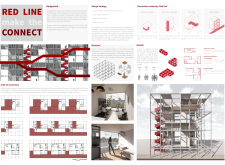5 key facts about this project
The architecture features a modular design that includes distinct living units suitable for singles, couples, and families. Each type of unit has been carefully crafted to optimize space while providing residents with the necessary privacy and comfort. The thoughtful arrangement of these units promotes interaction, where common areas and shared resources are seamlessly integrated within the living spaces. This layout encourages socializing and collaboration among residents, effectively breaking down the barriers often seen in high-density urban living. At the heart of the design is a concept referred to as the “Red Line,” a visual and physical pathway that connects the modular units, establishing a cohesive community flow.
Significant elements of the project emphasize both accessibility and sustainability. The design incorporates vertical connectivity through central staircases and shared common spaces, promoting ease of movement and further interaction between residents. Such spaces are not merely transitional— they are envisioned as vibrant hubs for community gatherings and daily activities, thus enhancing the quality of life for all who inhabit the building. Additionally, open-air terraces extend the living space outdoors, encouraging a connection with nature and providing residents with a venue for relaxation and socializing while integrating greenery to mitigate the urban heat island effect.
The project demonstrates a unique approach to architectural design through its focus on modularity and adaptability. By employing a consistent architectural language across the different household types, the design maintains visual harmony while allowing for flexibility that caters to the varying needs of future residents. The choice of materials—likely a combination of steel, concrete, and glass—further supports the project's functionality while also aligning with contemporary aesthetic preferences. The transparency offered by glass facades not only brings in natural light but also enhances the sense of openness, demonstrating an essential aspect of modern residential architecture.
Overall, "Red Line Make the Connect" is a reflection of thoughtful urban design principles that seek to redefine community living within an architectural framework. By addressing affordability without sacrificing the quality of interaction among residents, this project offers a meaningful contribution to the discourse surrounding urban housing solutions. For those interested in grasping a more detailed insight into this architectural endeavor, it is encouraged to explore the project presentation, which details the architectural plans, sections, designs, and the overarching ideas that led to this innovative approach.























